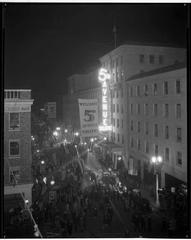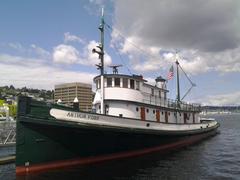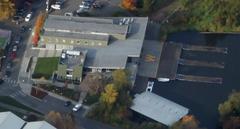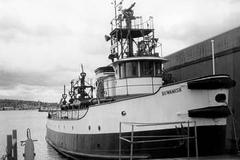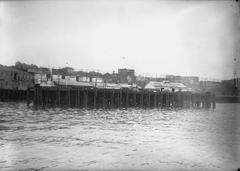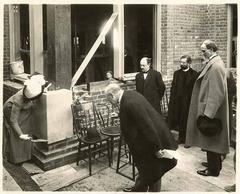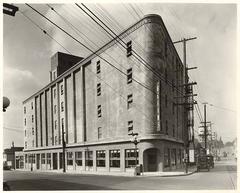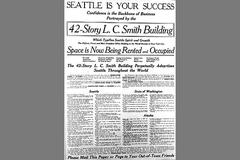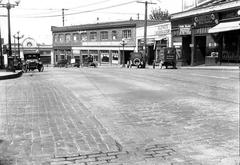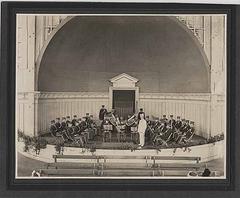
Union Station Seattle: Visiting Hours, Tickets, and Historical Sites Guide
Date: 04/07/2025
Introduction
Union Station Seattle is a distinguished architectural and cultural landmark in the heart of Pioneer Square. Originally constructed in 1911 to serve as a primary railroad terminal, Union Station is a testament to Seattle’s ambitions during the early 20th century. Its monumental Beaux-Arts and Roman Classic Revival design, characterized by an impressive barrel-vaulted Great Hall, terra cotta detailing, and elegant pilasters, reflects the era’s dedication to civic grandeur and architectural excellence (Wikipedia; Historic Structures; Lonely Planet).
Though passenger rail service ended in 1971, Union Station has undergone extensive preservation and adaptive reuse, now serving as the headquarters for Sound Transit and as a venue for public events within its meticulously restored Great Hall. Its central location, adjacent to the International District/Chinatown Light Rail station and near King Street Station and Pioneer Square, seamlessly blends historical heritage with modern urban life (Trains and Railroads; South Downtown Hub).
This comprehensive guide provides essential information on Union Station Seattle’s visiting hours, ticketing policies, accessibility, architectural highlights, nearby attractions, and practical travel tips. Whether you’re an architecture aficionado, history buff, or traveler exploring Seattle, this report will help you plan a memorable visit to Union Station—a living symbol of the city’s past, present, and transit future.
Table of Contents
- Historical Overview
- Visiting Hours, Tickets, and Accessibility
- Nearby Attractions and Travel Tips
- Photo Opportunities
- Frequently Asked Questions (FAQ)
- Conclusion: Experience Seattle’s Historic Union Station
- References
Historical Overview
Origins and Construction
Union Station was built in response to Seattle’s rapid growth, serving as the terminal for the Union Pacific Railroad and its subsidiary, the Oregon-Washington Railroad & Navigation Company. Construction commenced in January 1910, with the station officially opening on May 20, 1911. The site, previously home to Seattle’s first gas works, was chosen for its strategic location in the city’s commercial core (Wikipedia; Historic Structures; Atlas Obscura).
Architectural Significance
Union Station’s Roman Classic Revival style, designed by D.J. Patterson, features a reinforced concrete structure with brick veneer, terra cotta cornices, and a defining barrel-vaulted Great Hall. The hall is flooded with natural light from a semicircular window, and adorned with tiled floors, oak benches, and classical pilasters. The building’s grandeur was intended to rival nearby King Street Station and to signal Seattle’s emergence as a major urban center (HistoryLink; Atlas Obscura).
Role in Seattle’s Transportation Network
Serving both the Union Pacific and the Milwaukee Road railroads, Union Station was envisioned as a gateway to both domestic and international destinations—a vision only partially realized. Its location at 401 S. Jackson Street placed it at the crossroads of commerce, shipping, and travel in early Seattle (Wikipedia; Historic Structures).
Decline and Adaptive Reuse
With the rise of automobile and air travel, rail passenger numbers dwindled. By 1971, passenger operations had ceased, and the station’s Great Hall saw new life as an antique store until the building fell into disuse (Trains and Railroads). In the late 1990s, a major renovation spearheaded by Nitze-Stagen, with financial support from Paul Allen, restored the station’s historic character and adapted it for new uses (Wikipedia). The project received the National Historic Preservation Award in 2000.
Today, Union Station is the headquarters for Sound Transit and its Great Hall serves as a venue for public and private events.
Modern Urban Integration
Union Station is part of a larger office complex and sits adjacent to the International District/Chinatown Light Rail station. Though it no longer serves trains, its continued integration into Seattle’s transportation network, including future light rail expansion, ensures its ongoing relevance (Wikipedia).
Visiting Hours, Tickets, and Accessibility
Visiting Hours
- General Access: Union Station is typically open to the public Monday through Friday, 9:00 AM to 5:00 PM. The Great Hall is accessible primarily during scheduled public events, open houses, and private gatherings.
- Special Events: Access to the interior, especially the Great Hall, is most often available during public events. Check the Union Station events calendar or Sound Transit’s website for up-to-date event schedules.
Tickets and Admission
- Admission: There is no fee to visit Union Station or attend most public events. Some special events may require tickets or advance registration.
- Tours: Guided tours are not offered regularly, but may be available during certain public events or through local historical organizations.
Accessibility
- ADA Compliance: Union Station is fully wheelchair accessible, with ramps, elevators, and accessible restrooms.
- Amenities: Restrooms and seating are available during public events. The surrounding sidewalks in Pioneer Square may be uneven, so visitors with mobility needs should use caution.
Nearby Attractions and Travel Tips
Union Station’s central location offers easy access to some of Seattle’s most notable neighborhoods and attractions:
- King Street Station: A historic, active Amtrak and Sounder station next door.
- Chinatown–International District: A lively area for Asian cuisine, specialty shops, and the Wing Luke Museum.
- Pioneer Square: Known for its Romanesque architecture, art scene, and the Seattle Underground Tour.
- Smith Tower: Seattle’s original skyscraper, featuring an observatory and bar.
- Stadium District: Home to Lumen Field and T-Mobile Park.
Getting There:
Union Station is well-served by public transit, including the Link Light Rail, Seattle Streetcar, and many bus routes. Due to limited parking, public transit or rideshare is recommended (Seattle Streetcar Guide; Two Wandering Soles).
Photo Opportunities
- Exterior: The symmetrical façade, brick and terra cotta detailing, and classical arches.
- Great Hall: The soaring ceiling, large arched windows, and restored clock.
- Interior Details: Mosaic tile floors, marble finishes, and historic lighting fixtures.
- Neighborhood: Views of Pioneer Square’s streetscapes and nearby King Street Station.
When photographing, respect building policies and event-specific restrictions.
Frequently Asked Questions (FAQ)
Q: What are Union Station Seattle’s visiting hours?
A: Monday to Friday, 9:00 AM to 5:00 PM. The Great Hall is open primarily during public events—check the events calendar before visiting.
Q: Is there an admission fee or are tickets required?
A: General admission is free. Some special events may require tickets or registration.
Q: Can I take photographs inside Union Station?
A: Yes, during public events. Ask in advance if planning professional photography.
Q: Is Union Station wheelchair accessible?
A: Yes, with ramps, elevators, and accessible restrooms.
Q: Are guided tours available?
A: Not regularly, but may be offered during select public events.
Q: Is parking available?
A: No onsite parking. Paid lots and street parking are nearby, but public transit is recommended.
Conclusion: Experience Seattle’s Historic Union Station
Union Station Seattle offers a vivid window into the city’s early 20th-century transformation and its ongoing role in regional mobility and community life. The station’s Beaux-Arts grandeur, especially the restored Great Hall, invites admiration and reflection. Free admission, ADA accessibility, and a central location among Pioneer Square, the International District, and King Street Station make Union Station a must-visit for both locals and travelers.
For the latest information on visiting hours, events, and transit updates, download the Audiala app or follow official channels. Embark on an exploration of Seattle’s iconic landmarks with Union Station at the heart of your urban adventure.
References to official websites and credible sources for further reading
- Union Station (Seattle), 2024, Wikipedia (Wikipedia)
- Union Station Seattle: Visiting Hours, Tickets, and Historical Guide, Historic Structures (Historic Structures)
- Union Station Seattle: Architecture, History, and Practical Information, Lonely Planet (Lonely Planet)
- Union Station Seattle: Visiting Hours, Tickets, and Nearby Historical Sites, Accidentally Wes Anderson (Accidentally Wes Anderson)
- Union Station Seattle: Visiting Hours, Tickets, and Historical Guide, Trains and Railroads (Trains and Railroads)
- Union Station Seattle: Visiting Hours, Tickets, and Nearby Historical Sites, Seattle Streetcar Guide (Seattle Streetcar Guide)
- Union Station Seattle: Visiting Hours, Tickets, and Nearby Historical Sites, Nomadic Matt (Nomadic Matt)
- Union Station Seattle: Visiting Hours, Tickets, and Nearby Historical Sites, South Downtown Hub (South Downtown Hub)
























